






The big, blousy beauty of spring-blooming peonies simply doesn't last long enough.
Retain some of their good looks by drying them for a colorful display that can last for years.
Begin with newly opened blooms at their peak of freshness. Cut 6- to 8-inch stems in midmorning after the dew has lifted but before the heat of the day makes the petals open farther and go limp. Buds showing color can also be dried.
Remember that the colors will change as the flowers dry. Dark reds transform into a deep burgundy, brown, or purple, while whites may become creamy or pale yellow.
Once dried, you can group stems together in a vase, or use the flower heads alone to add color and texture to wreaths and swags.
Choose peonies to grow.
Air-Drying Peonies
Air-drying is the simplest, cheapest method of preserving peonies.
Cut stems at least 6 inches long, stripping off the lower foliage. If you want to create a bouquet now, arrange the blooms and cut the stems at the length you like, but group no more than three stems together so the flowers dry evenly.
Attach a rubber band or a piece of twine with a loop at the end around each stem or bunch, then hang the flowers upside down from a nail, dowel, or hanger. Or use a clothespin to attach the string or rubber band to the hanger.
Allow plenty of room between each flower to promote air circulation. The best location is a cool, dry room, such as an infrequently used closet, where little or no sunlight can reach the drying flowers.
Double or bomb types of peonies air-dry easier than those with single petals because hanging singles upside down turns the petals downward and inward, so the finished dried flower does not look open.
Learn about peony varieties.
Allow inverted peonies to dry for one to two weeks or until they are no longer limp when turned right side up.
Drying Peonies with Silica Gel
Silica gel, a desiccant purchased at crafts stores, takes less time and produces more vibrant colors than air-drying peonies. It is best used when drying peony heads, although you can dry an entire stem and the flower if you invest in a large amount of the product.
You will need a lidded container that will accommodate the height of the flower plus another 2 or 3 inches. Pour about 2 inches of silica gel, which resembles coarse sand, into the container.
Place the peony bloom face up on top of the gel. If you are drying more than one bloom, keep adjacent flowers separate. Gently add the powdery gel so it drops between and covers each individual petal. Continue delicately adding enough silica gel to the container until each flower is completely covered. A handheld, fine-mesh kitchen strainer may be a useful tool. Cover the container with its lid.
Check the peonies in two or three days, using care when removing the silica, which can be used again to dry more flowers.
Using the same technique, you may wish to experiment with household products such as white cornmeal, sand, borax, and unscented kitty litter.
Editor's Tip: To extend the stem of a dried flower head, clip your desired length of floral wire, place it against the remaining stem, and wrap both stem and wire with floral tape; tuck the wire ends into an arrangement or vase.
Caring for Dried Peonies
Keep dried peonies out of direct sunlight, which can fade the colors, and humidity, which makes the stems and petals limp. Avoid storing them in the fluctuating conditions of basements and attics.
You can clean dried peonies in wreaths and vases by simply blowing off the dust with a quick but light puff of breath or air. A handheld vacuum or other suction device is too powerful and will pull the petals apart.
Learn about other flowers that dry well.
Learn how to dry herbs.
Copyright © www.100flowers.win Botanic Garden All Rights Reserved